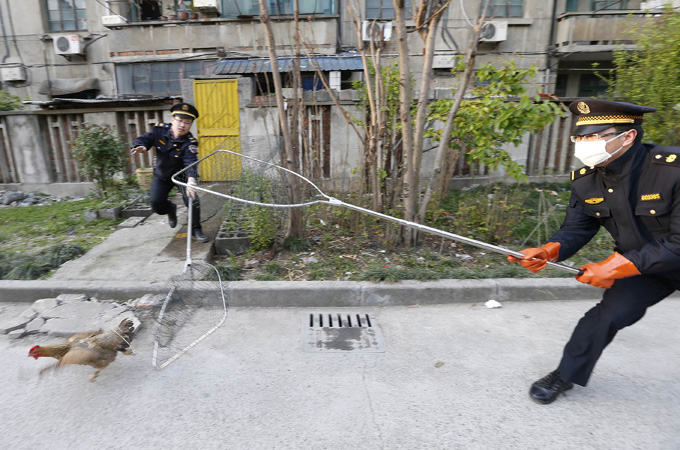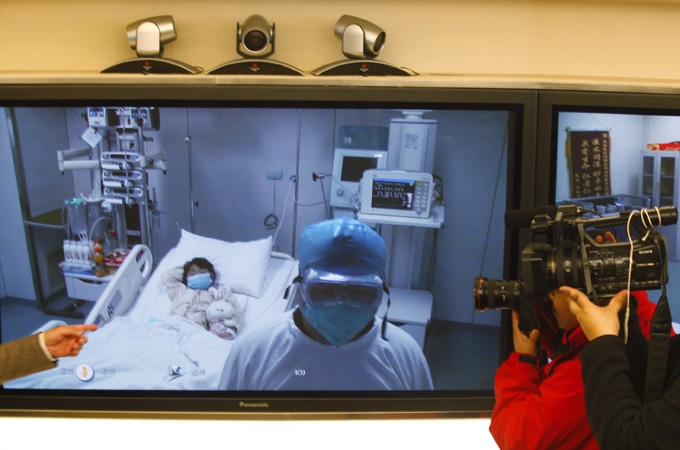Deadly new bird flu baffles China
Scientists are scrambling to find the origins of new H7N9 strain that has killed more than 20 and continues to spread.

Shanghai, China – A new strain of avian influenza has left World Health Organisation (WHO) scientists and Chinese authorities baffled as to its source, with more than 20 people dead from the virus and the number of cases continuing to rise.
The National Health and Family Planning Commission confirmed more than 100 cases of H7N9 reported in China, including 22 fatalities, as of Wednesday. Many of the infections have occurred in eastern China’s Yangtze River Delta region, with severe pneumonia killing most victims.
Keep reading
list of 4 itemsCould shipping containers be the answer to Ghana’s housing crisis?
Are Chinese electric vehicles taking over the world?
First pig kidney in a human: Is this the future of transplants?
In an attempt to prevent the further spread of the virus, Chinese authorities ordered the cull of thousands of chickens and other poultry earlier this month, after H7N9 was found in pigeons at a wholesale market in Shanghai’s Songjiang district.
While it was initially thought poultry was the source of the virus, the WHO recently said about half of the patients investigated did not come into direct contact with birds.
World Health Organisation official Gregory Hartl told Al Jazeera the source of the virus causing human infection is the most puzzling aspect of the H7N9 outbreak. Hartl also said it is possible that poultry is not the only cause of the virus’ spread.
|
“So far, we have not seen any instances of sustained human-to-human transmission.“ – Gregory Hartl, WHO |
Experts fear the virus could mutate in a way that allows it to spread easily among people, unleashing a global pandemic.
WHO investigating
A team of WHO experts travelled to China and with Chinese scientists are surveying areas affected by the virus to discover the source of its spread over the past three weeks.
WHO said last week 80,000 birds had been tested with only 40 having positive results for H7N9, leading scientists wonder what else could be responsible.
The team looked at family cluster cases. One case in particular was investigated after an 87-year-old father and his two sons contracted the H7N9 strain. The father and one of the sons later died from the virus, while the second son is reported to have recovered.
“This is an unusually dangerous virus for humans,” Keiji Fukuda, WHO’s assistant director-general for health security, said Wednesday. “This is definitely one of the most lethal influenza viruses that we’ve seen so far.”
The H7N9 flu has already resulted in almost twice as many infections in China as the H5N1 strain caused there in a decade, wrote Ho Pak-leung, an associate professor in the Department of Microbiology at the University of Hong Kong, in the British Medical Journal.
But Hartl said there’s no evidence yet of the virus being easily spread among humans.
“There may have been transmission of the virus within a family, but this is an instance of possible transmission only when there is close and prolonged contact,” Hartl said in an email. “So far, we have not seen any instances of sustained human-to-human transmission.”
 |
| City officers try to catch a runaway chicken [Reuters] |
Economic fallout
China’s financial capital Shanghai, with 23 million residents, has seen the most H7N9 fatalities with more than 30 cases and 12 deaths.
The city’s hundreds of live poultry markets have been shut down. Chicken sellers who previously brought livestock to the city in cages on the back of motorcycles and sold them freshly killed on the street have disappeared.
The poultry sector in China has been badly affected by the outbreak of the virus with reported losses of more than $2.1bn in sales of live poultry since the first case of the virus was confirmed.
Some residents have stopped eating chicken, and a few restaurants in Shanghai have scrapped it from the menu. One such restaurant is a popular American-style eatery called Piro. Manager Charles Zeng told Al Jazeera he made the decision to stop serving chicken.
“I don’t want my customers to get sick and I don’t want my chefs to touch chicken because they might get sick,” Zeng said. But he added people “still want chicken so they complain about not having it”.
Not all businesses have been negatively impacted. In a large five-story pharmacy on the busy shopping street of Nanjing Road in Shanghai, the counter selling modern and traditional cold and flu medicines was the busiest.
One Chinese remedy called ban lan gen, which is believed to have anti-viral properties, has proven particularly popular. A pharmacist – who did not want to be named, as is common in China – said hundreds of packets of the remedy were sold since the first case was announced.
Concern, not panic
Sitting on a bench on Shanghai’s Nanjing Road East, a man who gave only his surname Jiong said he stopped eating chicken, as well as pork, because of food safety issues.
More than 16,000 pigs were hauled out of rivers near Shanghai last month, raising fears that farmers were getting rid of diseased animals. The city’s animal disease control centre tested samples from the dead pigs for avian flu and didn’t find the virus.
 |
| A screen shows a girl who is infected with H7N9 [Reuters] |
An elderly man, who gave only one name Liu, told Al Jazeera the virus was not widespread and he was not worried. “Not so many people have gotten it considering the size of the population,” Liu said. But, he added, Liu and his wife were not eating chicken.
State media reported as of Monday 13 patients who were infected had recovered and were discharged from hospital after receiving treatment.
The joint WHO-China health team, meanwhile, is expected update its investigation this week.
The WHO’s Dr Michael O’Leary said an initial probe suggested easy H7N9 transmission among people that could emerge into a human pandemic didn’t appear to be the case in China.
“This is the very limited, rare sort of human-to-human transmission, rather than easy and sustained transmission,” O’Leary told journalists. “Right now it’s still an animal virus that occasionally infects humans.”
But the elusive source of what’s causing H7N9 to spread to humans remains disconcerting.
Dr. Bai Chunxue is a respiratory expert in Shanghai who treated the 87-year-old man and his infected sons. Family members told the doctor the men had no contact with fowl.
“To me, the biggest question is the link between the virus in birds and how it gets to humans. This is not clear, so this is indeed a mystery,” said Bai.